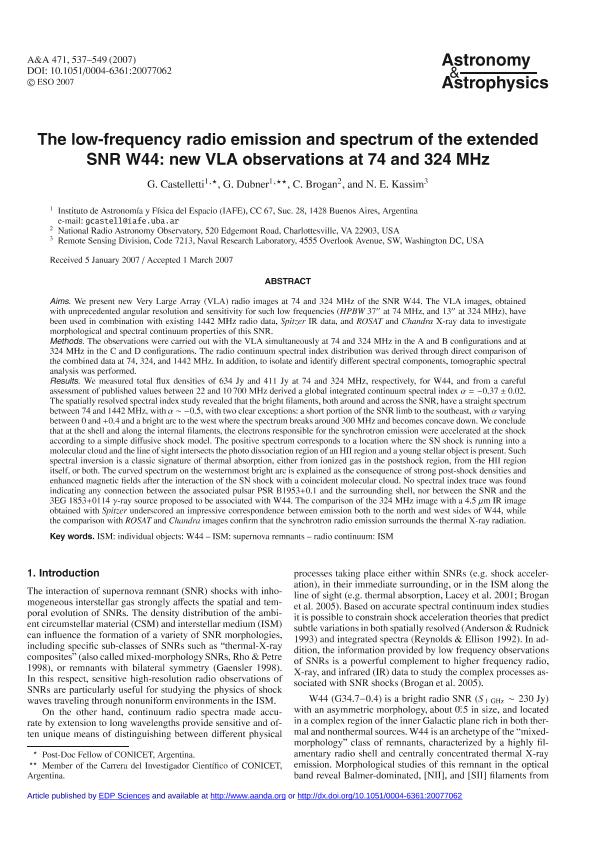Artículo
The low-frequency radio emission and spectrum of the extended SNR W44: new VLA observations at 74 and 324 MHz
Fecha de publicación:
12/2007
Editorial:
EDP Sciences
Revista:
Astronomy and Astrophysics
ISSN:
0004-6361
Idioma:
Inglés
Tipo de recurso:
Artículo publicado
Clasificación temática:
Resumen
Aims. We present new Very Large Array (VLA) radio images at 74 and 324 MHz of the SNR W44. The VLA images, obtained with unprecedented angular resolution and sensitivity for such low frequencies (HPBW 37 at 74 MHz, and 13 at 324 MHz), have been used in combination with existing 1442 MHz radio data, Spitzer IR data, and ROSAT and Chandra X-ray data to investigate morphological and spectral continuum properties of this SNR. Methods. The observations were carried out with the VLA simultaneously at 74 and 324 MHz in the A and B configurations and at
324 MHz in the C and D configurations. The radio continuum spectral index distribution was derived through direct comparison of the combined data at 74, 324, and 1442 MHz. In addition, to isolate and identify different spectral components, tomographic spectral analysis was performed. Results. We measured total flux densities of 634 Jy and 411 Jy at 74 and 324 MHz, respectively, for W44, and from a careful assessment of published values between 22 and 10 700 MHz derived a global integrated continuum spectral index α = −0.37 ± 0.02. The spatially resolved spectral index study revealed that the bright filaments, both around and across the SNR, have a straight spectrum between 74 and 1442 MHz, with α ∼ −0.5, with two clear exceptions: a short portion of the SNR limb to the southeast, with α varying
between 0 and +0.4 and a bright arc to the west where the spectrum breaks around 300 MHz and becomes concave down. We conclude that at the shell and along the internal filaments, the electrons responsible for the synchrotron emission were accelerated at the shock according to a simple diffusive shock model. The positive spectrum corresponds to a location where the SN shock is running into a molecular cloud and the line of sight intersects the photo dissociation region of an HII region and a young stellar object is present. Such spectral inversion is a classic signature of thermal absorption, either from ionized gas in the postshock region, from the HII region itself, or both. The curved spectrum on the westernmost bright arc is explained as the consequence of strong post-shock densities and enhanced magnetic fields after the interaction of the SN shock with a coincident molecular cloud. No spectral index trace was found indicating any connection between the associated pulsar PSR B1953+0.1 and the surrounding shell, nor between the SNR and the 3EG 1853+0114 γ-ray source proposed to be associated with W44. The comparison of the 324 MHz image with a 4.5 µm IR image obtained with Spitzer underscored an impressive correspondence between emission both to the north and west sides of W44, while the comparison with ROSAT and Chandra images confirm that the synchrotron radio emission surrounds the thermal X-ray radiation.
Ke
Palabras clave:
Ism: W44
,
Ism: Supernova Remnants
,
Radio Continuum: Ism
Archivos asociados
Licencia
Identificadores
Colecciones
Articulos(IAFE)
Articulos de INST.DE ASTRONOMIA Y FISICA DEL ESPACIO(I)
Articulos de INST.DE ASTRONOMIA Y FISICA DEL ESPACIO(I)
Citación
Castelletti, Gabriela Marta; Dubner, Gloria Mabel; Brogan, C.; Kassim, N. E.; The low-frequency radio emission and spectrum of the extended SNR W44: new VLA observations at 74 and 324 MHz; EDP Sciences; Astronomy and Astrophysics; 471; 2; 12-2007; 537-549
Compartir
Altmétricas




